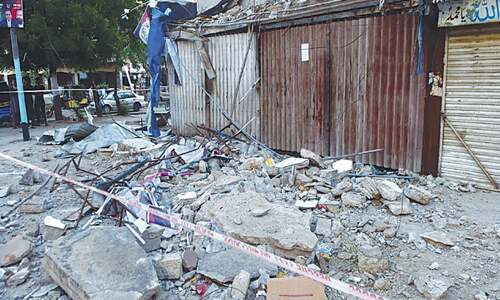KARACHI: The Sindh police’s ‘video surveillance system’, which has more than 1,000 closed-circuit television cameras across Karachi, has been found ineffective in identifying people as investigators believe the two-megapixel devices are helpful in monitoring but they do not give a worthwhile result when it comes to recognising suspects captured in the footage, it emerged on Wednesday.
A number of investigators and senior police officers that Dawn spoke to shared their experiences saying that the footage of different incidents recorded by the police cameras only helped understand them the way a crime was committed.
They cited several cases when the footage or pictures from the police cameras were sent for the identification of the suspects to the National Database Registration Authority (Nadra) and such requests were turned down by the federal body on technical grounds.
“For instance, the Karachi police had recently announced a Rs5 million reward for assistance or help in arrest of two targeted killing suspects, whose footage was recorded while they were riding away after targeting a policeman in Saddar in November 2014,” said a senior officer, who was tasked to investigate recent killings of policemen.
“The footage was considered crucial as it has happened on many occasions that the movement of policemen’s killers was recorded a few minutes before or after the incident. We grabbed their pictures from the CCTV footage and released them to the media and Nadra for identification of those suspects and to seek the people’s help in their identification. But during all this process we were sure that it would be of no help as the pictures, finalised after due procedure, were of very poor quality.”
Citing quality of the pictures, he said, they showed motorcyclists, one wearing a helmet and the other a cap, moving towards their target but their faces, blurred due to the low quality of the cameras, remained unrecognisable — both for the common man and the high-tech Nadra.
The Sindh police in 2010 launched the ‘video surveillance system’ for Karachi with an initial Rs500 million estimated cost. The project was further expanded last year when the law enforcement agency announced another Rs846 million project to install more surveillance cameras at important locations in the city in addition to the 1,000 cameras to meet the growing security challenges and help make the ongoing ‘targeted operation’ a success.
Apart from its own surveillance system, the Karachi police supervise the KMC’s command and control centre at the Civic Centre after the Sindh government in September 2013 replaced the Citizens-Police Liaison Committee (CPLC) with the law enforcement agency, in a major move a day after the federal government had announced the launch of the Rangers-led targeted operation in the city.
However, a senior official associated with the Sindh police video surveillance project confirmed that the cameras installed across the city were of two-megapixel quality, which were only helpful in monitoring the metropolis, and attempts to identify the suspects through the devices had failed.
“Actually, it was the first experience of its kind in Karachi, even in the country,” said the official. “We initiated the project with the two-megapixel cameras, which are definitely not powerful enough to record or grab perfect footage or picture of the suspects from 15- to 20-foot height where they are installed. We are working on more modern technology, so one may hope that the quality of this system will improve gradually.”
Concerns about the utility of surveillance arise not only from the regular investigation arms of the Karachi police, but also from specialised units, which are mandated to investigate heinous crimes ranging from terrorist activities to killings and from extortion to kidnapping for ransom.
“The only surveillance cameras which have been effective so far in identification of suspects are those installed inside ATM facilities by the banks,” said Raja Umer Khattab, chief of the CID police counterterrorism unit.
“This is not because they are of very high quality, but because they are installed close to the machines and in a narrow space where they record the footage. The cameras elsewhere, whether installed inside banks or across the city, can only help you monitor the situation. They can’t help in identifying anyone.”
Published in Dawn, January 15th, 2015
On a mobile phone? Get the Dawn Mobile App: Apple Store | Google Play














































